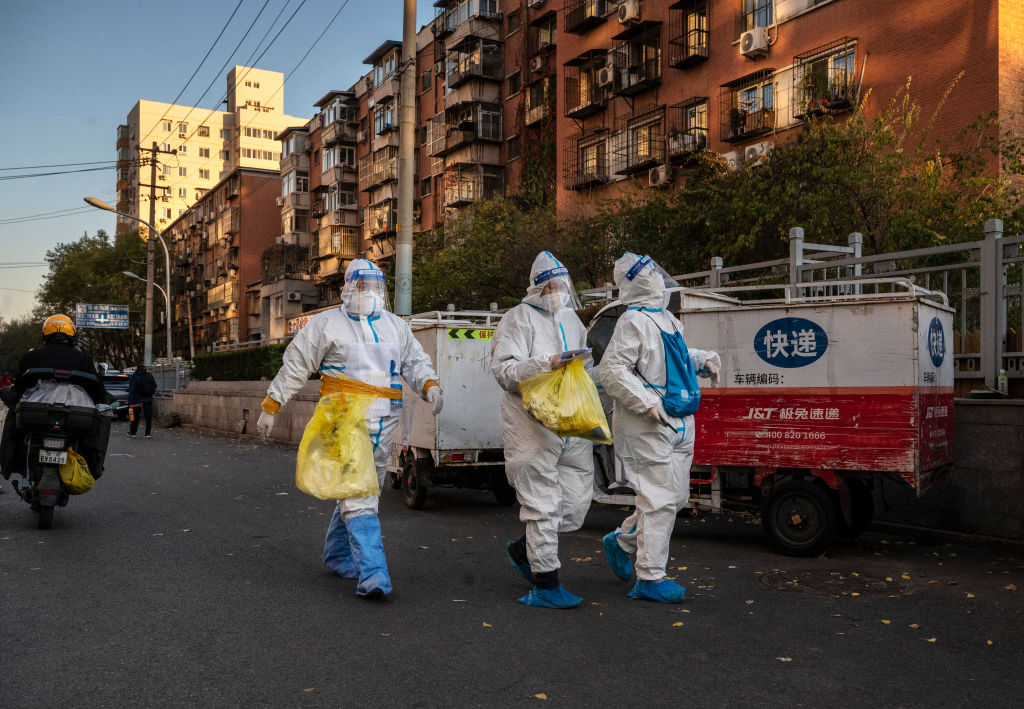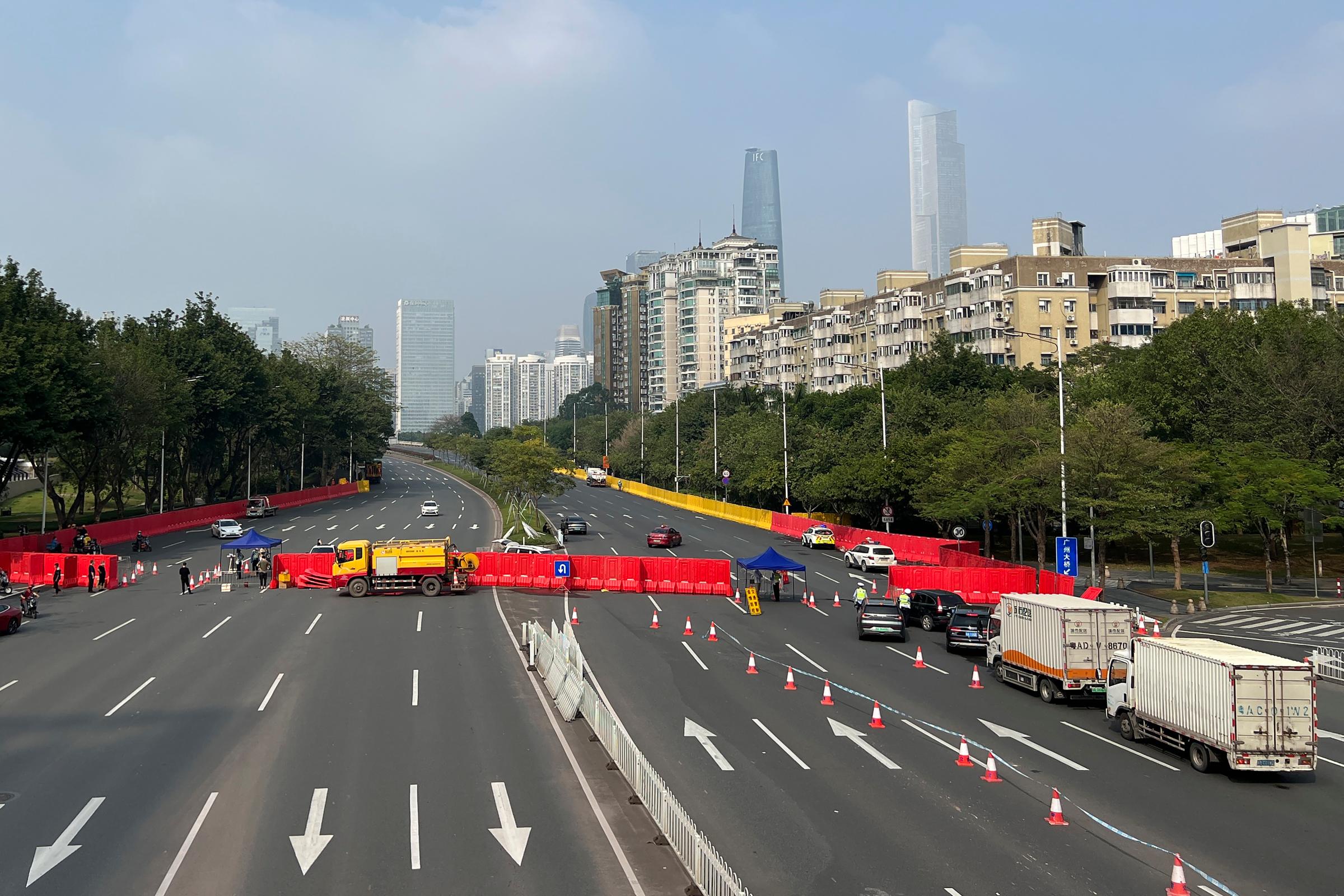
A relaxation of some COVID-19 control measures, including shorter quarantine requirements, in China on Friday sent stocks soaring. The announcement of the changes added fuel to speculation in recent weeks that China might soon move away from its zero-COVID policies that have hammered the economy and kept the country largely closed off from the rest of the world for more than two years.
But some experts believe the news may actually be a sign that China plans to maintain its zero-COVID approach for the foreseeable future rather than phase it out.
Read More: China’s Zero-COVID Policy Is Causing An Economic Crisis
“These policy adjustments look more like efforts to sustain zero-COVID,” Yanzhong Huang, a senior fellow for global health at the Council on Foreign Relations, tells TIME. That’s partly because the incentive structure hasn’t changed: “Local governments are still held accountable for the COVID situations in their jurisdictions,” he says, “and there is no credible punishment on local governments’ excessiveness.”
The measures announced Friday—which will make entering the country easier—include a reduction in the amount of time travelers need to spend in a central quarantine facility from five to seven days. A “circuit breaker” rule, which triggered flight route suspensions if too many passengers tested positive on arrival, was also scrapped.
Assumptions, however, that zero-COVID is on its way out, experts suggest, are unfounded and may be due to wishful thinking as well as the relative lack of accurate information coming out of China. They point out that what’s happening on the ground in Guangzhou, where the virus’ epicenter has shifted, shows that zero-COVID is likely here to stay.
How China’s pandemic policies stand out
Over the last year, other countries have moved to lift their policies on COVID-19. Many western countries have decided to live with the virus, and the stay-at-home measures that were in place early in the pandemic are long gone, as are most masking and quarantine requirements.
But China has continued to use lockdowns to try to stamp out virus cases. In August, tens of thousands of Chinese tourists were stranded on the resort island of Sanya after a lockdown was imposed. Early last month, residents of far-western Xinjiang were banned from leaving after a virus outbreak there, and nearly all flights in and out of the region were canceled. When Wuhan reported around 20 new infections a few weeks ago, authorities ordered more than 800,000 people in one district to stay at home. As of late October, 28 Chinese cities were implementing some form of lockdown measures, impacting more than 200 million people, analysts from the financial services firm Nomura told Reuters.
More from TIME
China currently has the strictest containment measures in the world, according to researchers at Oxford University who developed an index based on thirteen metrics: school closures, workplace closures, cancellation of public events, restrictions on public gatherings, closures of public transport, stay-at-home requirements, public information campaigns, restrictions on internal movements, international travel controls, testing policy, extent of contact tracing, face coverings, and vaccine policy.
Relaxation rumors dashed by reality on the ground
Some observers speculated that the Chinese President might begin loosening COVID-19 countermeasures after he secured a precedent shattering third term in October, hopes shared by at least some Chinese residents. In early November, Hong Kong stocks surged after rumblings on social media, based on an unauthenticated post, that Chinese officials were discussing rolling back some of the country’s draconian zero-COVID policies (many of the stocks listed in Hong Kong are those of mainland companies). The rally was buoyed further when Reuters reported that a former Chinese disease control official told a banking conference that China would make “major changes” to its COVID policies in the next few months.
That’s despite Chinese officials shooting down such rumors. Asked at a press conference earlier this month if there would be a change of policy in the near term, disease control official Hu Xiang said China’s measures are “completely correct, as well as the most economical and effective.” She said that China “should adhere to the principle of putting people and lives first, and the broader strategy of preventing imports from outside and internal rebounds.”
Evidence that zero-COVID isn’t going away anytime soon is currently on display in Guangzhou, a manufacturing hub of 13 million people in southern China. Last week, local authorities ordered residents of districts with a population of almost 5 million people to stay home at least through Sunday, according to the Associated Press. Public transportation and schools were suspended across the city, and thousands of flights were canceled.

Taylor Loeb, a senior analyst at the consultancy Trivium China, says the response to the outbreak in Guangzhou shows that little has changed in terms of Beijing’s zero-COVID policies, which has severely disrupted life across China, and damaged the economy, for much of the past few years as authorities have implemented harsh lockdowns and mass testing to quash infections. “What we’re seeing in Guangzhou is reminiscent of what we’ve seen elsewhere over the past two-and-a-half years,” says Loeb.
“The reliance on the same playbook in responding to the outbreak,” says Huang, “suggests that Beijing has no plans to give up the zero-COVID mentality anytime soon.”
Why do some people believe zero-Covid is going away?
Loeb says reopening rumors may be gaining traction because there have been so many negative catalysts for markets in recent years—tech and private education crackdowns, deteriorating relations with the West, an increased consolidation of power around Xi. “The likelihood of any of those trends reversing is slim to none. COVID policy, on the other hand, will change course someday. It’s just unclear when. The market is looking for anything positive out of China,” he says.
He adds that an information vacuum isn’t helping the problem. It has become increasingly difficult for many western media outlets to report from the mainland, and many foreign journalists have left the country. “The desire for a positive catalyst mixed with a shaky information ecosystem creates the perfect environment for rumors to spread,” he says.
The social media post in early November that caused a market rally worth hundreds of millions of dollars stemmed from an unverified post on WeChat. It claimed, according to Bloomberg News, that China’s fourth-highest ranking official Wang Huning held a meeting with COVID-19 experts and that they discussed “speeding up a conditional opening plan, with the goal of substantially opening by March next year.”
Will China ever get rid of zero-COVID?
It appears that China’s strict virus countermeasures will stay in place for the foreseeable future. “There will be small tweaks, as there have been over the last few months,” Loeb says, “but there thus far is simply no indication of significant policy easing anytime soon.”
Huang says that Xi might be forced to give up on zero-COVID if local government officials no longer have the fiscal capacity or popular support to sustain enforcement of the policies. “I expect that to happen in the coming year,” he says.
Videos of protests against local officials have circulated on social media. The death of a 3-year-old boy earlier this month sparked an outpouring of public anger; his father had claimed on social media that COVID workers had prevented him from leaving their compound to seek treatment for his son after a suspected gas leak.
But the measures announced on Friday, which authorities said were a refinement, not a relaxation of the rules, “would reduce the excessiveness in [zero-COVID] policy implementation,” Huang says, which might make prolonged enforcement more feasible.
When it comes to the possibility of fundamental change to the zero-Covid approach, one sign Loeb says he’ll be watching out for is any change in how Chinese leaders talk about the severity of COVID.
That might not happen any time soon though, particularly in the coming winter months as infections may rise. Beijing, Chongqing, Guangzhou and Zhengzhou reported record COVID-19 cases on Monday.
But whenever it does happen, Loeb adds that the several years of zero-COVID being in place may make a quick U-turn difficult. “It’s not even clear that living with the virus is feasible in China, given how effective Beijing’s messaging has been around the severity of COVID,” he says. “Much of the population has already internalized that messaging.”
More Must-Reads from TIME
- L.A. Fires Show Reality of 1.5°C of Warming
- Home Losses From L.A. Fires Hasten ‘An Uninsurable Future’
- The Women Refusing to Participate in Trump’s Economy
- Bad Bunny On Heartbreak and New Album
- How to Dress Warmly for Cold Weather
- We’re Lucky to Have Been Alive in the Age of David Lynch
- The Motivational Trick That Makes You Exercise Harder
- Column: No One Won The War in Gaza
Write to Amy Gunia at [email protected]